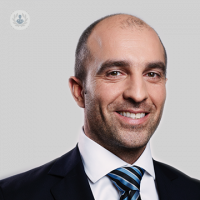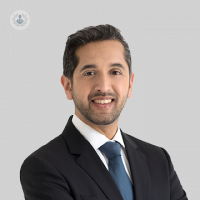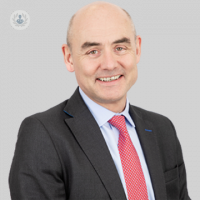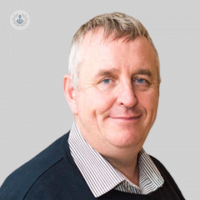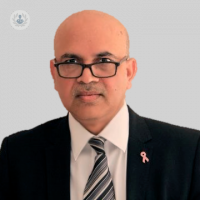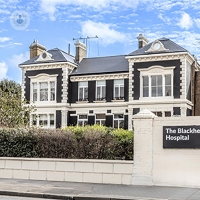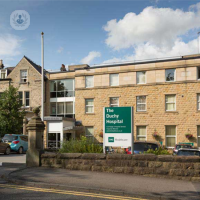What is gynaecomastia?
Gynaecomastia, occasionally referred to as ‘man boobs’, is the medical term for enlarged male breasts. It is a common hormonal disorder that only affects males, making their breasts larger than normal due to an excess quantity of male breast tissue. It usually occurs more in teenage boys and older men.

The extent of gynaecomastia symptoms varies from person to person. Some males find they have a small amount of excess breast tissue around their nipples, whilst others may have noticeably larger male breasts. In some cases, gynaecomastia may cause discomfort or tenderness in the breasts.
What are the causes of gynaecomastia?
There are several causes of gynaecomastia. One of the main causes is believed to be hormone imbalance, when more oestrogen is produced than normal and less testosterone. Oestrogen causes male tissue to grow at an abnormal rate. Although all males produce a certain amount of oestrogen, they also produce bigger quantities of testosterone which prevents the growth of breast tissue. In some cases, the reason for this hormonal balance is not known.
Obesity can also cause gynaecomastia, as being overweight may increase oestrogen production making the breasts larger. For this reason, patients who have dieted and done exercise to lose weight may find that they still have enlarged breasts.
Gynaecomastia in newborn babies occurs due to oestrogen passing from the mother through the placenta and to the baby. The breasts usually return to a normal size a few weeks after the baby’s birth. During puberty, some male adolescents may also find that their breasts grow as their hormone levels vary, but this usually stabilises as they grow older. Gynaecomastia in older men is caused by decreased production of testosterone. As older men often have more body fat, their oestrogen production increases thus causing the breasts to enlarge.
Other possible causes of gynaecomastia include drinking too much alcohol, and consuming illegal drugs or prescribed medications, among others.
Can gynaecomastia be prevented?
Although the condition is not always avoidable, there are some measures one can take in order to prevent gynaecomastia. These include following a proper diet, exercising, drinking less alcohol, avoiding certain drugs and medications such as steroids and marijuana (which has been linked to increased levels of oestrogen production).
What is the treatment for gynaecomastia?
In some cases, treatment for gynaecomastia may be recommended. Gynaecomastia treatment includes breast reduction surgery to remove the excess male breast tissue, or medication aimed at correcting the hormonal imbalance behind enlarged male breasts.
11-13-2012 07-28-2023Gynaecomastia
Mr Sam Orkar - Plastic surgery
Created on: 11-13-2012
Updated on: 07-28-2023
Edited by: Conor Dunworth
What is gynaecomastia?
Gynaecomastia, occasionally referred to as ‘man boobs’, is the medical term for enlarged male breasts. It is a common hormonal disorder that only affects males, making their breasts larger than normal due to an excess quantity of male breast tissue. It usually occurs more in teenage boys and older men.

The extent of gynaecomastia symptoms varies from person to person. Some males find they have a small amount of excess breast tissue around their nipples, whilst others may have noticeably larger male breasts. In some cases, gynaecomastia may cause discomfort or tenderness in the breasts.
What are the causes of gynaecomastia?
There are several causes of gynaecomastia. One of the main causes is believed to be hormone imbalance, when more oestrogen is produced than normal and less testosterone. Oestrogen causes male tissue to grow at an abnormal rate. Although all males produce a certain amount of oestrogen, they also produce bigger quantities of testosterone which prevents the growth of breast tissue. In some cases, the reason for this hormonal balance is not known.
Obesity can also cause gynaecomastia, as being overweight may increase oestrogen production making the breasts larger. For this reason, patients who have dieted and done exercise to lose weight may find that they still have enlarged breasts.
Gynaecomastia in newborn babies occurs due to oestrogen passing from the mother through the placenta and to the baby. The breasts usually return to a normal size a few weeks after the baby’s birth. During puberty, some male adolescents may also find that their breasts grow as their hormone levels vary, but this usually stabilises as they grow older. Gynaecomastia in older men is caused by decreased production of testosterone. As older men often have more body fat, their oestrogen production increases thus causing the breasts to enlarge.
Other possible causes of gynaecomastia include drinking too much alcohol, and consuming illegal drugs or prescribed medications, among others.
Can gynaecomastia be prevented?
Although the condition is not always avoidable, there are some measures one can take in order to prevent gynaecomastia. These include following a proper diet, exercising, drinking less alcohol, avoiding certain drugs and medications such as steroids and marijuana (which has been linked to increased levels of oestrogen production).
What is the treatment for gynaecomastia?
In some cases, treatment for gynaecomastia may be recommended. Gynaecomastia treatment includes breast reduction surgery to remove the excess male breast tissue, or medication aimed at correcting the hormonal imbalance behind enlarged male breasts.
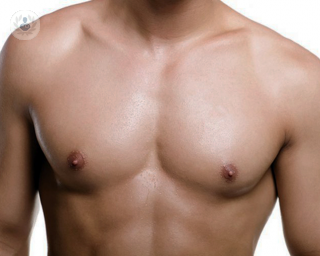

Gynaecomastia: causes, symptoms, and treatment
By Professor Philip Drew
2025-01-14
Gynaecomastia is a male-affecting condition whereby a man's breasts will experience abnormal growth. It is, unfortunately, an extremely common condtion that affects men of all ages, but one that thankfully can be effectively treated. In this article, esteemed consultant oncoplastic breast surgeon, Professor Philip Drew, provides a comprehensive analysis of gynaecomastia, outlining the causes, symptoms, and main treatment options. See more


The VASER Liposuction procedure step-by-step
By Dr Hassan Nurein
2025-01-14
VASER Liposuction is an increasingly popular minimally-invasive technique for treating patients with gynaecomastia. We spoke to experienced cosmetic surgeon Dr Hassan Nurein about how the procedure works and what patients can expect at each stage. See more


Should I be worried about gynaecomastia?
By Dr Costantino Davide
2025-01-14
Gynaecomastia is a condition that causes male breasts to swell and become larger than they normally should be. In our latest article, leading London-based plastic, reconstructive, and cosmetic surgeon, Dr Costantino Davide, shares his expertise on gynaecomastia. He explains what causes it, how it's treated, and whether surgery is always necessary. See more
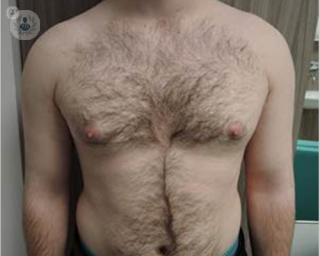

How can gynaecomastia be treated or corrected?
By Mr Deemesh Oudit
2025-01-14
Here, Mr Deemesh Oudit, a highly experienced consultant plastic surgeon, talks to us about the condition that can severely affect a man’s self-esteem: gynaecomastia. See more
Experts in Gynaecomastia
-
Mr Mo Akhavani
Plastic surgeryExpert in:
- Breast augmentation
- Facelift
- Gynaecomastia
- Tummy tuck (abdominoplasty)
- Liposuction
-
Mr Maisam Fazel
SurgeryExpert in:
- Tummy tuck (abdominoplasty)
- Oncoplastic and reconstructive breast surgery
- Gynaecomastia
- Breast reduction
- Breast reconstruction
- Breast cancer surgery
-
Mr Paul Harris
Plastic surgeryExpert in:
- Breast reduction
- Breast augmentation
- Breast lift or mastopexy
- Breast implant removal surgery
- Gynaecomastia
- DIEP breast reconstruction
-
Professor Ged John Byrne
SurgeryExpert in:
- Family history of breast cancer
- Oncoplastic and reconstructive breast surgery
- Breast cancer surgery
- Breast reconstruction
- Gynaecomastia
- Breast implant removal surgery
-
Mr Kislaya Kumar Thakur
SurgeryExpert in:
- Breast cancer surgery
- Breast surgery
- Male breast cancer
- Mastalgia
- Gynaecomastia
- Mastitis
- See all

The Blackheath Hospital - part of Circle Health Group
The Blackheath Hospital - part of Circle Health Group
40-42 Lee Terrace, Blackheath, London SE3 9UD
No existe teléfono en el centro.
By using the telephone number provided by TOP DOCTORS, you automatically agree to let us use your phone number for statistical and commercial purposes. For further information, read our Privacy Policy
Top Doctors

The Duchy Hospital - part of Circle Health Group
The Duchy Hospital - part of Circle Health Group
Queen's Road, Harrogate HG2 0HF
No existe teléfono en el centro.
By using the telephone number provided by TOP DOCTORS, you automatically agree to let us use your phone number for statistical and commercial purposes. For further information, read our Privacy Policy
Top Doctors

Signature Clinic Glasgow
Signature Clinic Glasgow
79 W Regent St, Glasgow
No existe teléfono en el centro.
By using the telephone number provided by TOP DOCTORS, you automatically agree to let us use your phone number for statistical and commercial purposes. For further information, read our Privacy Policy
Top Doctors
-
The Blackheath Hospital - part of Circle Health Group
40-42 Lee Terrace, Blackheath, London SE3 9UD, East LondonExpert in:
- Vascular Surgery
- Cardiology
- Bariatric Surgery
- Colorectal surgery
- Endocrine Surgery
- General Surgery
-
The Duchy Hospital - part of Circle Health Group
Queen's Road, Harrogate HG2 0HF, HarrogateExpert in:
- Cardiology
- General Surgery
- Plastic surgery, reconstructive and aesthetics
- Diagnostic Imaging
- Ophthalmology
- Otolaryngology
-
Signature Clinic Glasgow
79 W Regent St, Glasgow, GlasgowExpert in:
- Abdominoplasty
- Blepharoplasty
- Facelift
- Cosmetic gynaecology
- Gynaecomastia
- Liposuction
- See all
- Most viewed diseases, medical tests, and treatments
- Facial feminisation surgery
- Hormone therapy
- Migraine
- Nutrition
- Weight loss injections
- Endermologie
- Polynucleotides
- Nipple discharge
- Abdominal pain
- Endovenous laser treatment (EVLA)

